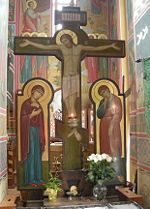Golgota: Diferență între versiuni
(→Locul) |
|||
| Linia 2: | Linia 2: | ||
==Locul== | ==Locul== | ||
| − | The possible source of the word Golgotha has been attributed variously. The name "Golgotha" could have been adopted since, historically, this place may have originally been a place of public executions where the skulls of the executed could be seen or, perhaps the name may have been derived from a neighboring cemetery, or it may have been connected with the shape of the ground, a hill which may have resembled a skull. According to tradition, Golgotha was the burial place of Adam's skull <ref>Rev. Dr. Nicon D. Patrinacos (M.A., D.Phil. (Oxon)). ''A Dictionary of Greek Orthodoxy - Λεξικον Ελληνικης Ορθοδοξιας''. Light & Life Publishing, Minnesota, 1984. pp.181</ref> and a shrine exists at this site. The location was identified in 326 AD by Empress [[ | + | The possible source of the word Golgotha has been attributed variously. The name "Golgotha" could have been adopted since, historically, this place may have originally been a place of public executions where the skulls of the executed could be seen or, perhaps the name may have been derived from a neighboring cemetery, or it may have been connected with the shape of the ground, a hill which may have resembled a skull. According to tradition, Golgotha was the burial place of Adam's skull <ref>Rev. Dr. Nicon D. Patrinacos (M.A., D.Phil. (Oxon)). ''A Dictionary of Greek Orthodoxy - Λεξικον Ελληνικης Ορθοδοξιας''. Light & Life Publishing, Minnesota, 1984. pp.181</ref> and a shrine exists at this site. The location was identified in 326 AD by Empress [[Elena]], the mother of [[Constantine the Great]]. It was on the northwest side of the ancient city.<ref>[http://www.gospel-mysteries.net/golgotha.html Golgotha]</ref> |
| − | + | [[Biserica Sfântului Mormânt (Ierusalim)]] pe locul pe care [[tradiţia]] creştină l-a considerat a fi "Golgota", menţionat cu acest nume în [[Noul Testament]] ca loc al crucificării lui Iisus. | |
| − | [[Image:GalgothaStNickDC.JPG|right|thumb|150px| | + | [[Image:GalgothaStNickDC.JPG|right|thumb|150px|Reprezentarea iconică Golgota - Catedrala Sf. Nicolae, Washington, D.C.]] |
==Reprezentarea iconică "Golgota"== | ==Reprezentarea iconică "Golgota"== | ||
Versiunea de la data 24 iunie 2011 21:08
| Acest articol (sau părți din el) este propus spre traducere din limba engleză!
Dacă doriți să vă asumați acestă traducere (parțial sau integral), anunțați acest lucru pe pagina de discuții a articolului. |
| Acest articol face parte din seria Țara Sfântă și Iudaismul în timpul Mântuitorului |
|||
| Curente religioase și partide politice | |||
| Saducheii – Fariseii | |||
| Esenienii – Zeloții – Irodienii | |||
| Instituții | |||
| Sanhedrinul - Marele Preot Templul din Ierusalim Legea lui Moise | |||
| Oameni | |||
| Irod cel Mare – Arhelau – Irod Antipa Irod Agripa al II-lea Pilat din Pont Anna – Caiafa Iosif din Arimateea – Fariseul Nicodim Femeile mironosițe Fotini samarineanca Mariamna - Irodiada | |||
| Locuri | |||
| Ierusalim Betleem – Nazaret Galileea – Muntele Tabor – Marea Galileei Betania – Ghetsimani – Muntele Măslinilor Golgota Samaria – Ierihon Cezareea | |||
| Editați această casetă | |||
Golgota (gr. Κρανιου-τοπος (Kraniou Topos); lat. Calvariae Locus; aramaică Gûlgaltâ; sl. паннихида, pannikhída - "locul căpăţânii") este locul unde a fost crucificat Iisus, situat în afara zidurilor vechiului Ierusalim. Uneori "Golgota" este şi numele unei reprezentări iconice a crucificării Mântuitorului.
Locul
The possible source of the word Golgotha has been attributed variously. The name "Golgotha" could have been adopted since, historically, this place may have originally been a place of public executions where the skulls of the executed could be seen or, perhaps the name may have been derived from a neighboring cemetery, or it may have been connected with the shape of the ground, a hill which may have resembled a skull. According to tradition, Golgotha was the burial place of Adam's skull [1] and a shrine exists at this site. The location was identified in 326 AD by Empress Elena, the mother of Constantine the Great. It was on the northwest side of the ancient city.[2]
Biserica Sfântului Mormânt (Ierusalim) pe locul pe care tradiţia creştină l-a considerat a fi "Golgota", menţionat cu acest nume în Noul Testament ca loc al crucificării lui Iisus.
Reprezentarea iconică "Golgota"
În bisericile ortodoxe, Golgota este o reprezentare iconică de mari dimensiuni a crucificării lui Iisus, situată în spatele sfintei mese a altarului. Mai rar, sunt reprezentaţi şi Maica Domnului şi Apostolul Ioan, ca în icoana crucificării. În anumite tradiţii locale, această reprezentare iconică este scoasă în mijlocul naosului când se fac parastase.
În timpul Săptămânii Patimilor Golgota este scoasă de preot sau de episcop în mijlocul bisericii spre închinare într-o procesiune de la utrenia din Vinerea Mare, în timp ce strana cântă de trei ori troparul:
- Astăzi s-a răstignit pe lemn Cel ce a spânzurat pământul pe ape.
- Cu cunună de spini a fost încununat Împăratul îngerilor.
- Cu porfiră mincinoasă a fost îmbrăcat Cel ce îmbracă cerul cu nori.
- Lovire peste obraz a luat Cel ce a liberat în Iordan pe Adam.
- Cu piroane a fost pironit Mirele Bisericii.
- Cu suliţa a fost împuns Fiul Fecioarei!
Închinămu-ne Patimilor Tale, Hristoase, arată-ne nouă şi slăvită Învierea Ta.
Note
A se vedea şi
Surse
- Rev. Dr. Nicon D. Patrinacos (M.A., D.Phil. (Oxon)). A Dictionary of Greek Orthodoxy - Λεξικον Ελληνικης Ορθοδοξιας. Light & Life Publishing, Minnesota, 1984.
- Wikipedia:Golgotha/
